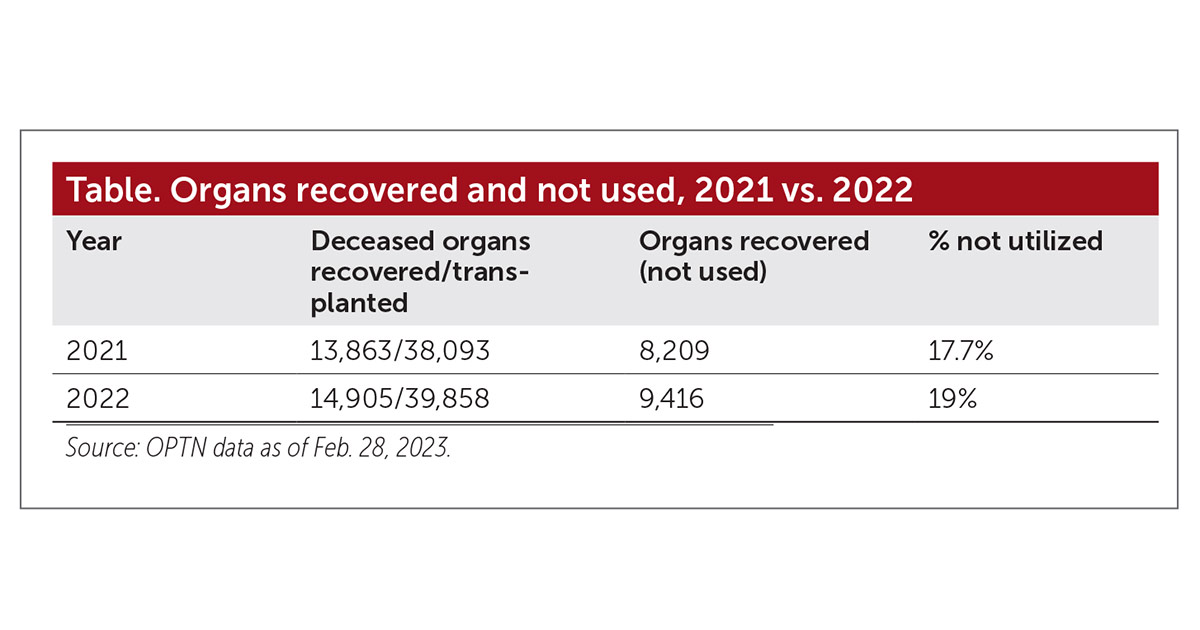High rate of donated organs going unused is costing lives
Every year, thousands of donated organs, primarily kidneys, go to waste because transplant centers decline to accept the organs for patients.

This is a reality that few outside of the transplant specialty are discussing. Despite calls from many corners of government to improve the organ donation and transplantation system, the non-use of donated organs is far down the list of concerns. Fixing this one issue, however, could lead to more lives saved each year than any other reform on the federal government’s list.
Setting records
In the past 12 years, organ procurement organizations (OPOs) have set records in the number of organs recovered for transplantation. In 2022 alone, there was a 7.5% increase in deceased organ donation and a 4.6% increase in organs transplanted from deceased donors compared with 2021. That is 14,905 deceased organ donors and 39,858 organs transplanted from deceased organ donors.
Last year, 9,416 organs were recovered by OPOs and offered to transplant centers, but not accepted for transplant – representing 19% of all recovered organs. This accounts for an almost 15% increase in overall non-utilization from 2021 to 2022. Of that number, 7,540 or 26% were kidneys – the most in-demand organ for patients awaiting a transplant (see chart).
Experts say that 62% of those kidneys would have been viable and could have been transplanted. This means 4,675 patients on dialysis could have received a kidney but did not.
Equally concerning is transplant centers often reject these kidneys without patients’ knowledge. A study led by Sumit Mohan, MD, MPH, professor of medicine and epidemiology at Columbia University, showed that every kidney patient who dies on the waitlist has had 16 kidneys rejected on their behalf, which were ultimately accepted by another transplant center and transplanted into another patient.
In a nation where chronic kidney disease is considered an epidemic impacting 37 million patients, such waste is unconscionable. This is especially true for Black Americans, who make up 35% of patients with kidney failure. In a government-commissioned report last year on U.S. organ donation and transplantation system, the National Academies of Sciences, Engineering, and Medicine (NASEM) declared that the non-use of organs is more prominent in the U.S. than in any other country.

Our organ transplant system stands to make significant headway if we do the necessary work to heighten utilization of available organs for transplantation. With more than 100,000 patients still desperately waiting for lifesaving organ transplants, we cannot hesitate to remedy these systemic failures.
‘Yes’ to organs
The NASEM report recommends that the Organ Procurement Transplantation Network (OPTN) enhance organ allocation and distribution policies and processes to decrease the non-utilization of deceased donor organs by making it easier for transplant centers to say “yes” to organ offers. The report suggests transplant centers implement refined filters to indicate preferences for which kidneys will be accepted.
In addition, expedited placement policies must be implemented for procured kidneys that are at high risk of not being used, aimed at redirecting difficult-to-place kidneys to transplant centers that have historically accepted kidneys from medically complex or older donors. The report also advises changes to transplant center surgical scheduling to eliminate the “weekend effect,” in which organs that become available on Friday, Saturday and Sunday are less likely to be accepted and transplanted.
The Association for Organ Procurement Organizations (AOPO) supports these measures, as well as the implementation of an organ screening system that documents the cause behind the non-use of every organ, to improve transparency and help us identify solutions to increase organ acceptance. Furthermore, AOPO has suggested updates to the organ allocation system to reduce the number of patients offered an organ with known deferrals.This would expedite the matching process and decrease the number of non-used organs, especially given the narrow timeframe for organ viability.
OPOs are actively striving to boost donation and transplant rates following recent regulations implemented by CMS. These updated rules have necessitated adjustments on the part of OPOs to enhance organ availability.
New regulations
Under the new regulations, OPOs are evaluated based on the number of organs recovered and successfully transplanted, also known as the transplant rate. However, this metric is predominantly influenced by transplant centers. Without interventions aimed at promoting higher acceptance of organs offered by OPOs, these organizations are at risk of being labeled as “failing” and potentially facing decertification.
We strongly advocate for comprehensive reforms in the regulations governing transplant centers to ensure that more organs recovered by OPOs are used to save lives.
Click here to read a response by Kenneth Andreoni, MD; and Ginny L. Baumgardner, MD, PhD, FACS, on behalf of the executive committee of the American Society of Transplant Surgeons.
- References:
- Aubert O, et al. JAMA Int. Med. 2019;doi:10.1001/jamainternmed.2019.2322.
- Chronic kidney disease in the United States, 2021. https://www.cdc.gov/kidneydisease/publications-resources/ckd-national-facts.html.
- Fifty thousand organ transplants in 2026 – AOPO. https://aopo.org/50k-transplants/.
- Husain S. et al. JAMA Network Open. 2019;doi:2(8):e1910312.
- Millenson, M. No ‘weekend surgery’ dooming many awaiting life-saving transplants, says a new report. Forbes, 2022; www.forbes.com/sites/michaelmillenson/2022/03/06/no-weekend-surgerydooming-many-awaiting-life-saving-transplants-report/?sh=fb451752d337.
- NASEM Report National Academies of Sciences, Engineering, and Medicine. 2022. Realizing the promise of equity in the organ transplantation system. Washington, DC: The National Academies Press: 33-34 https://doi.org/10.17226/26364.
- Race, ethnicity, and kidney disease. 2023. National Institute of Diabetes and Digestive and Kidney Diseases; https://www.niddk.nih.gov/health-information/kidney-disease/race-ethnicity.
- For more information:
- Barry Massa is the executive director at LifeCenter Organ Donor Network in Cincinnati, and immediate past president of the board for the AOPO. He can be reached at bmassa@lifepassiton.org.
